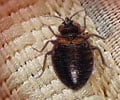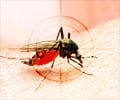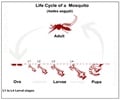- Guidelines for treatment of malaria, World Health Organization - (http://apps.who.int/iris/bitstream/10665/162441/1/9789241549127_eng.pdf)
- Cholera - (https://www.cdc.gov/cholera/index.html)
- Typhoid - (https://www.cdc.gov/typhoid-fever/index.html)
- Rhino virus infection - (http://emedicine.medscape.com/article/227820-overview)
Introduction
After the scorching summer, monsoon brings the much needed respite from the heat. However, with the pleasant temperature, the monsoon season also brings a whole range of common infections, which can become life-threatening if timely treatment is not taken.
Monsoon diseases can be differentiated based on how they spread:
- Air Borne Diseases: Common cold, flu type illness
- Water and Food Borne Diseases: Typhoid , cholera, hepatitis-A, gastroenteritis, and leptospirosis
- Mosquito Borne Diseases: Malaria, dengue and chikungunya
Air Borne Diseases
Common Cold:
The commonest cause for falling ill during the monsoon season is due to common cold. This is a viral infection and is usually caused by rhino virus, though there are other viruses as well.
These viruses thrive in low humidity conditions. They usually infect the upper respiratory tract (nose and throat). Common cold is highly contagious and spreads easily due to dispersal of the virus containing droplets when patient sneezes or coughs. It also spreads by hand contact of the nasal and oral secretions. When a healthy person touches a surface containing these secretions and then touches his nose, he develops the infection.
Symptoms can be mild and the patient usually has fever, muscle aches, runny nose, stuffy nose, cough, sore throat, earache, loss of appetite and so on. Symptoms are self-limiting and settle within a week.
It is diagnosed clinically and usually laboratory tests are not needed.
Treatment is supportive, and patient is advised to drink plenty of fluids and keep himself warm. He can take paracetamol for fever and a pain killer (ibuprofen) for body pains. He can also take anti-histamines (cetirizine) and decongestants (phenylephrine) to relieve a runny nose and stuffy nose symptoms.
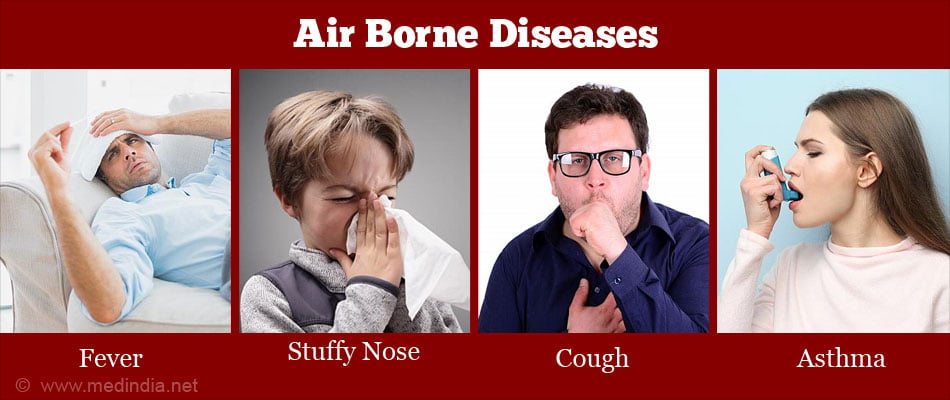
Flu Type Illness:
This is caused commonly by influenza and parainfluenza viruses. Symptoms are similar to common cold, but are more severe and last longer than a week. Sometimes patients may have medium-high grade fever with chills and severe tiredness. Children may have nausea or vomiting.
Unlike common cold, flu can worsen into pneumonia, and this is a serious infection especially in children, elderly, pregnant women, and in patients with low immunity like asthma, COPD, diabetes, among others.
It spreads in a similar way to common cold. Flu is also diagnosed clinically without the need for laboratory investigations initially. The patient is advised rest, to keep himself warm, oral fluids, paracetamol for fever and painkillers (Ibuprofen or naproxen). Aspirin should be avoided in children, as it can trigger a severe reaction called Reyes’ syndrome.
High risk patients are prescribed anti-viral medications (Oseltamivir, Zanamivir or Paramivir) to shorten the duration of infection and prevent complications.
Antibiotics are usually not needed unless there are secondary bacterial infections.
Tips To Prevent Air-borne Infections
- Take warm fluids like soups, green tea, warm water with honey and lemon.
- Cover your nose and mouth when you cough or sneeze.
- Use tissues to blow the nose and dispose them in the bin securely.
- Wash hands or use hand sanitizer regularly after your blow your nose.
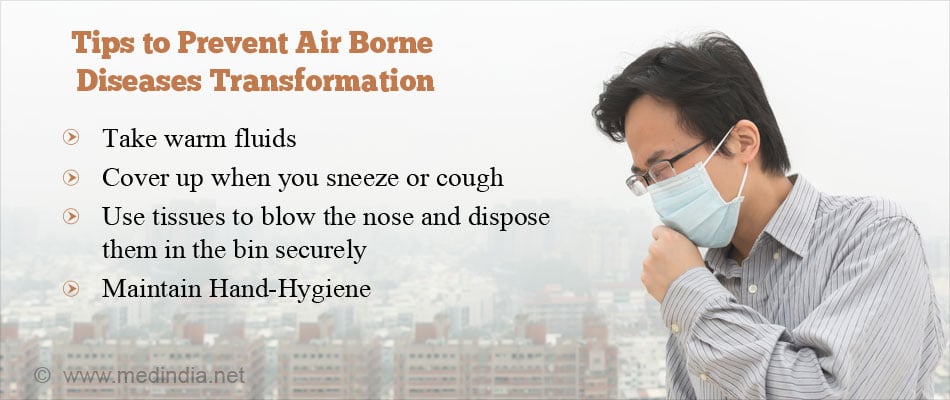
Water and Food Borne Diseases
These diseases spread when drinking water or food gets contaminated with urine or feces of infected animals or humans. They can also spread by direct contact. Leptospira can infect the soil as well.
Gastroenteritis:
This is the common stomach ailment seen in the monsoon season. It is commonly called food. Both viruses (mostly rota virus) and bacteria can cause gastroenteritis.
Symptoms include stomach cramps, fever, diarrhea, nausea, vomiting. If severe, the patient becomes tired, dehydrated with poor urine output and may have altered consciousness.
This is usually diagnosed clinically; laboratory tests are not needed in mild cases. If symptoms are severe, then stool culture and blood culture to identify the offending organisms, complete blood picture, CRP and so on can be done.
The goal of treatment is rehydration by replenishing the fluids and salts that are lost. The patient is prescribed oral rehydration salt fluids (ORS). Coconut water, butter milk or rice kanji water is also beneficial. Consume bland food like rice, yogurt or bland soups. Fruits like banana, apple can be taken. Anti-emetics like prochlorperazine, domperidone may help to stop the vomiting. Antibiotics and anti-protozoal medication like Norfloxacin-Tinidazole combination can be prescribed, if symptoms are severe. Paracetamol can be taken, if the patient has fever.
Cholera:
An important but deadly bacterial infection seen commonly during the monsoon is cholera, caused by Vibrio cholera bacteria.
Symptoms include severe vomiting and watery diarrhea, called rice water stools. This results in severe dehydration and electrolyte imbalance rapidly leading to muscle cramps. Diagnosis is by clinical examination and by a rapid dipstick test to identify Vibrio cholera bacteria in the stool sample.
Treatment should be given rapidly, otherwise it can be fatal. Treatment is by IV fluids and oral rehydration salt therapy.
Typhoid:
Typhoid is another bacterial infection caused by Salmonella species. Symptoms include persistent high grade fever, severe abdominal pains, nausea, vomiting, headache and tiredness. It is diagnosed by blood and stool cultures and by Widal test.
Treatment is by IV fluids, paracetamol for fever and antibiotics like macrolides (azithromycin), fluoroquinolones (levofloxacin) or third generation cephalosporin (cefotaxime).
Hepatitis A:
Hepatitis A is a liver infection caused by Hepatitis A virus. Jaundice (yellow skin, yellow eyes and dark urine), abdominal pain, nausea, vomiting, loss of appetite, fever, diarrhea, tiredness are the symptoms. It is diagnosed by blood tests that detect hepatitis A virus in the body.
There is no specific treatment and management usually includes rest, paracetamol to control fever, and anti-emetics for nausea and vomiting. The damaged liver recovers within a few months.
Leptospirosis:
Leptospirosis is a disease caused by Leptospira bacteria. The bacteria enter the body through skin or mucous membrane of eyes, mouth or by drinking contaminated water.
Symptoms include high fever, chills, muscle aches, headache, nausea, vomiting, diarrhea, jaundice, abdominal pain, rash, red eyes, among others. Some patients may be asymptomatic. The person may recover and may fall ill again, this is more severe and is called Weil’s disease and includes kidney failure, liver failure and brain infection.
Treatment is with antibiotics like Doxycycline and Penicillin and supportive measures like fluids and paracetamol for fever.
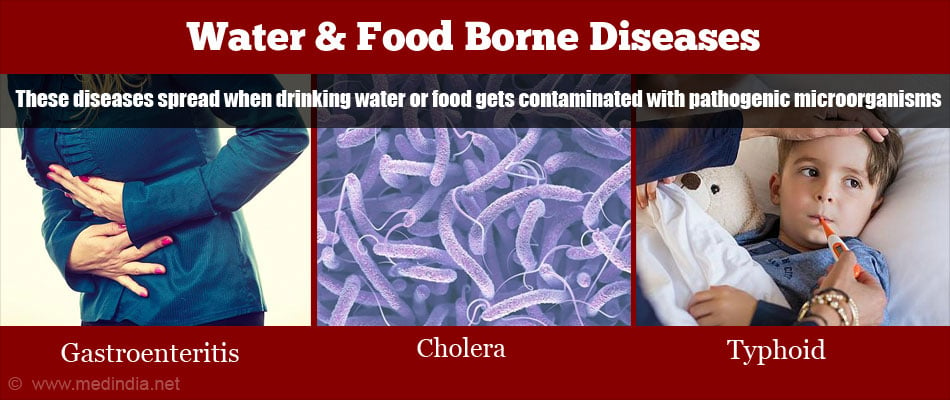
Tips to Prevent Water-borne Diseases
- Wash hands properly after a bowel movement and follow good hygiene.
- To prevent dehydration take small sips of fluids, continuously throughout the day.
- Avoid food from road side stalls, as the surroundings may be unhygienic.
- Maintain good sanitary conditions around residential areas.
- Drink boiled and cooled water, mineral water or use water from a purifier.
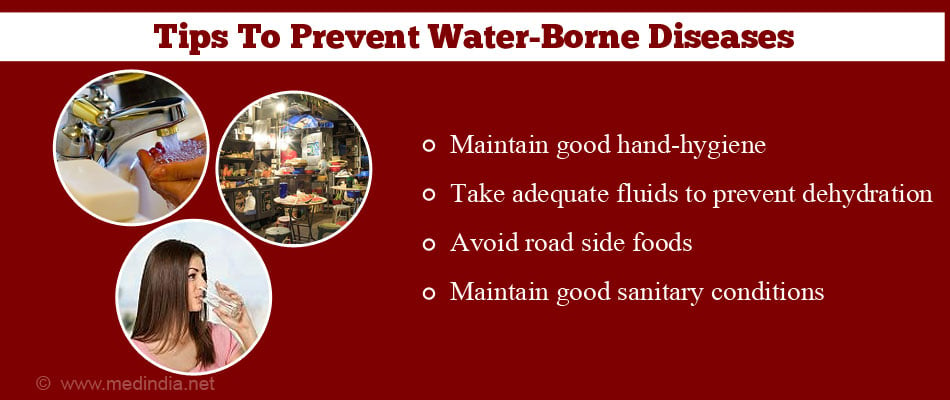
Mosquito Borne Diseases
Mosquitoes are vectors that can transmit diseases between humans or between animals and humans. When a mosquito bites an infected person and then bites a healthy person, the infection causing organism (parasite, virus) enters the healthy person and causes disease in him.
Malaria:
Malaria is a common blood disease caused by Plasmodium parasite and spread by infected female Anopheles mosquitoes. The mosquito breeds in dirty stagnant water.
Symptoms include high fever with chills, sweating, tiredness, headache, nausea, vomiting, diarrhea, abdominal pain and muscle cramps. In severe infection, there is multi-organ damage and patient may have bleeding disorder, anemia, respiratory distress, kidney, spleen or liver failure, bloody stools, jaundice, alteration in consciousness, convulsions/fits or can go into coma.
Malaria is diagnosed both by symptoms and clinically. Laboratory tests include thick and thin blood smears to identify the parasite; antigen based Rapid diagnostic test, complete blood picture, kidney and liver function tests and so on.
Treatment is by Artemisinin combination therapy for Plasmodium falciparum malaria and mixed type of malarias, Chloroquine is drug of choice for Plasmodium vivax malaria.
Dengue Fever:
Dengue, also called as break bone fever is caused by Dengue virus which is spread by female Aedes mosquitoes, also known as the tiger mosquito due to its black and white stripe appearance. This mosquito breeds in fresh and clean water and feeds during day time. Symptoms include high fever > 104 deg F, headache, muscle and joint pain, nausea, vomiting, rash, swollen glands, pain behind the eye ball and the like.
Symptoms usually settle within a week, but in some cases can become life-threatening. Blood vessels are damaged and become leaky and platelet count drops, this leads to dengue hemorrhagic fever and dengue shock syndrome. Severe symptoms include abdominal pain, bleeding from mouth and nose, blood in urine and stool, circulatory collapse, rash, breathing problems, tiredness, restlessness, cold skin and so on.
Diagnosis is by isolation of the virus from blood samples collected within 5 days of onset of symptoms or fourfold increase in IgG or IgM antibody titers in paired serum samples. Rapid diagnostic kits can be used, there may be a decrease in platelet count and increase in hematocrit value. Other investigations include total leucocyte count and differential leucocyte count, kidney and liver function tests and peripheral smear.
Currently there are no known anti-viral medications against dengue virus, hence treatment is mainly supportive – patient is given rest, oral fluids, paracetamol for fever (ibuprofen and aspirin are avoided as it can increase the bleeding tendency). Platelets count should be regularly monitored. In severe cases, platelet or blood transfusion is given.
Chikungunya:
Chikungunya is an infection caused by Chikungunya virus and spread by infected female Aedes mosquitoes. The name Chikungunya is originated from the Kimakonde language and it means “to become contorted” and refers to the stooped position adopted by the affected person due to joint pains.
High grade fever and joint pains are the main symptoms, which can be debilitating lasting for few days to weeks/months. Other symptoms include headache, muscle pain, nausea, vomiting, tiredness, rash etc.
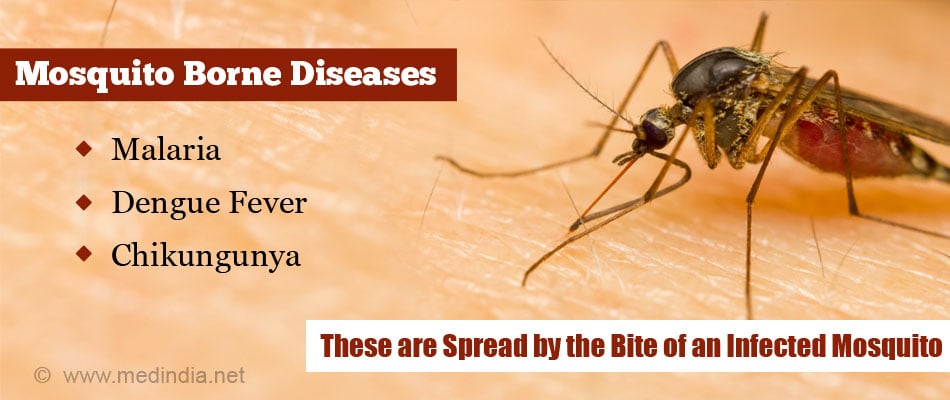
Tips to Prevent Mosquito Borne Infections
- Avoid water stagnation (e.g. in buckets, broken pots and tyres)
- Cover open drains.
- Cover yourself fully to prevent being bitten.
- Use mosquito repellents (on the skin, clothes and in the room) and mosquito nets for the doors/windows and cots.
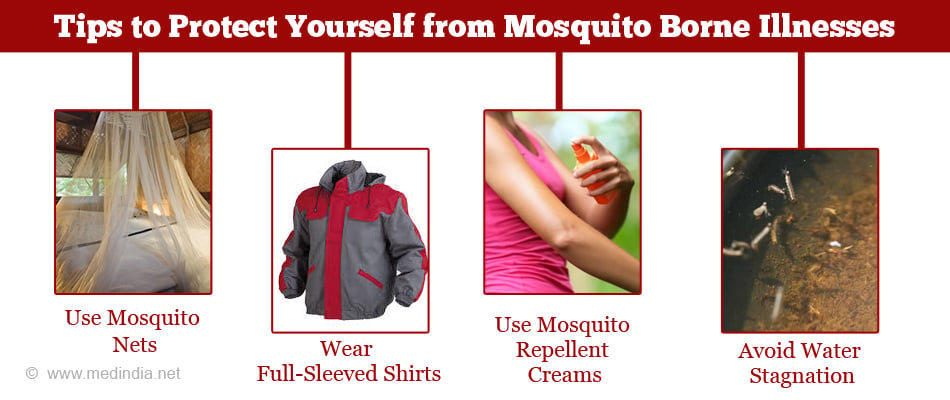
Fungal Infections
Fungal infections of the skin are quite common in monsoon season. Increasing humidity and increased sweating can cause the fungal organisms to thrive in damp areas of skin like armpits, underneath the breasts, groins, between the toes and so on. Symptoms include rash and itching. It is diagnosed clinically and treatment is by using anti-fungal ointments.
Tips to Prevent Fungal Infection
- Dry the skin fold areas regularly to prevent sweat and moisture accumulation
- As fungal infections are contagious, avoid sharing towels and undergarments.
- Avoid public swimming pools.

Health Tips
- Eat a well-balanced diet with plenty of fruits and vegetable to improve your immunity to fight the infections.
- If you have got wet in the rain, dry yourself or change into dry clothes as soon as possible.
- Keep a safe distance from a person who has cold to avoid catching the infection.
- Avoid visiting crowded places like exhibitions, pandals, and theatres during the monsoon season.


